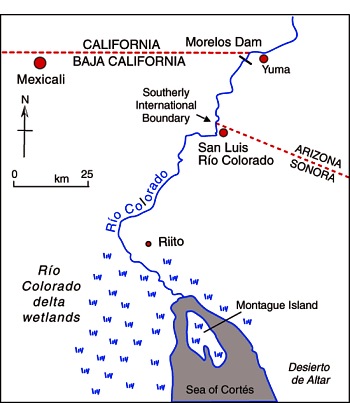A few months ago, we highlighted the outstanding work of photographer Peter McBride. McBride traveled the length of the Colorado River from its source high in the Rocky Mountains to its vast delta in the otherwise arid Sonoran desert in northern Mexico where the river emptied into the Sea of Cortés (Gulf of California). Now, McBride has released (on Yale Environment 360) a visually stunning video about his experiences tracing the Colorado River. The last third or so of the video focuses on the Colorado delta region in northern Mexico.
McBride follows the natural course of the Colorado “by raft, on foot, and overhead in a small plane, telling the story of a river whose water is siphoned off at every turn, leaving it high and dry 80 miles from the sea.”
The river enters Mexico (see map below) at the Southerly International Boundary where a gauging station records the river’s discharge. Sadly, this river is one of the most altered river systems in the world.The Río Colorado delta wetlands once created ideal conditions for a rich variety of wildlife. Today, the Río Colorado wetlands have been reduced to about 5% of their original extent, and the potential water supply for the rapidly-growing urban centers of Mexicali, Tijuana, Tecate and Rosarito has been compromised.
Related articles:
- Fascinating new book about the Colorado River
- Dust, snowmelt and the reduced flow of the Colorado River into Mexico
- USA agrees to “bank” some of Mexico’s entitlement of Colorado River water
- April earthquake leads to Mexico-USA talks over water-sharing
Rivers, reservoirs and water-related issues are discussed in chapters 6 and 7 of Geo-Mexico: the geography and dynamics of modern Mexico. Ask your library to buy a copy of this handy reference guide to all aspects of Mexico’s geography today! Better yet, order your own copy…

Sorry, the comment form is closed at this time.